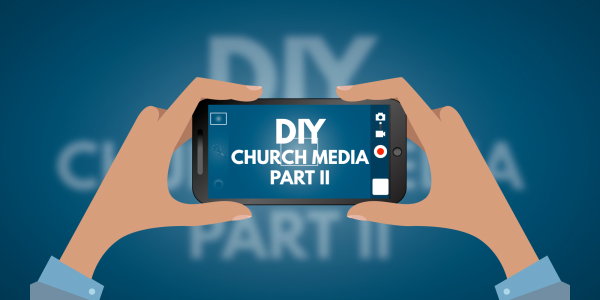
If you’d like to add a personal touch to your church media and can’t find what you’re looking for on WorshipHouse Media or SermonSpice, maybe it’s time unleash your inner-photographer and design some promotional material for your church, DIY style.
This series will help guide you through the creative, rewarding process of incorporating church members into your media. It’s a fantastic way to make the Sunday experience resonate with your congregation, and best of all, you don’t need to be a professional (or filthy rich) to get great results.
In our last post, we discussed the importance of telling a story visually and planning your composition long before you shoot it. If you haven’t already, give it a read here! This time, we’ll review some tips on how to compose and shoot photographs like a professional, even if you’re not one. The one disclaimer to keep in mind is that you’ll likely need to be patient with yourself. It may take a few photo shoots before all of these concepts come together, so don’t beat yourself up if you don’t hit a home run on your first at-bat. With that in mind, let’s talk DIY photography!
NO DSLR? NO PROBLEMO!
You don’t need the finest equipment on the market to produce high quality compositions. As long as you keep the following tips in mind, a decent camera phone will do the trick:
Good lighting is critical
The lighting of your photos is probably the most important factor to consider when shooting. Most professional photographers rely on a stable of finely calibrated flashes, light modifiers and artificial lighting. But fear not, fellow amateurs, the Lord’s got us covered. The best type of light was made on the first day of creation and is free to all, so if your composition allows for it, get outside for the shoot.
One thing to keep in mind when photographing outdoors: be conscious of the position of the sun and the shadows that it casts. For example, be mindful to position yourself, if possible, so that the sun is behind you and not your subject (aka frontlighting). Also make sure you’re not getting splatter/hot spots in your photos. If your subject is standing under a tree, for example, the sunlight poking through the leaves will likely cause light spots and shadows… and you don’t want that. During the shoot, your eye won’t notice it much, but when you start downloading the pics, you’ll see it immediately. To combat this lighting issue, have someone hold a large piece of cardboard to block the hotspots, or adjust your subject’s position so that the light and shadows aren’t so prevalent.
If you’re planning a photo session at your church, or anywhere indoors, try taking some pictures near the biggest window you can find. Position your subject so that the window lights them from the side and you’ll likely get a dynamically lit shot.
Composition is key
So, uh, remember when I told you that lighting was the most important factor to your photo shoot? Well, I could be wrong about that, because the composition of your shots is probably just as critical. Hopefully you’ve hashed a lot of this out when planning your overall design, but if not, no worries. Keep these three things in mind and you’ll be good to go:
-
The Rule of thirds
Learn it… jedi master it… your future self will think highly of you.
-
Get creative with your angles
During your shoot, get creative and take pictures from different angles for dynamic results. Crouch, lean, or contort your body, just try to think outside the box… or stand on top of it, or have your subject stand on it. Maybe pull a Zacchaeus. The bottom line is, you don’t want to end up with a bunch of shots that look the same, and shooting from interesting angles can make for intriguing results. Use positioning to focus on the theme and help tell a story that will resonate with your audience.
-
Never forget your Background
What’s going on in the background of your photos is also very important. The Lord made your brain especially talented at focusing on a subject and tuning everything else out, which works great in real time, but in photography it’s much the opposite. Unless for some reason the background helps to tell the story, ensure that it isn’t cluttered- no unintended signs, bystanders, etc. This is easy to fix by moving a bit or adjusting the angle of your shot.
IN REVIEW
You don’t need to be a professional to create awesome church promotional materials. You don’t even need fancy cameras or equipment. All you need to do is plan your design, be mindful of your lighting and always remember that composition is critical.
In the next post, we’ll look at practical and legal factors in choosing a model for your photo shoot. We’ll also explore simple, effective ways to enhance your homemade church media and different ways to use it.
So did we miss any important photography do’s and don’ts in this post? Let us know your thoughts, questions and DIY photo shoot experiences in the comments section below!




